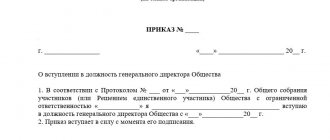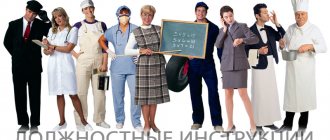Legal aspects of the work of structural divisions
A structural unit cannot be considered separately from the enterprise, because it is not endowed with legal or economic independence. In accordance with the legislation, the following features of these structural units can be distinguished:
- if the management of the enterprise has decided that it is necessary to create a structural unit, then there is no need or obligation to report this to the registration authorities;
- registration with tax authorities, pension and insurance funds is not required;
- no separate accounting documents are maintained for the structural unit, and its activities are reflected in the general balance sheet of the organization;
- a separate statistical code is not assigned for this link;
- It is not allowed to open separate bank accounts for a structural unit.
Specifics
The creation of units is based on data on the type of activity, number of personnel, location and other characteristics. Consider this example: a company produces concrete blocks, the advertising department handles sales, and accounting is the responsibility of the accounting department. But there is a significant difference between different subjects. Thus, the structural divisions of a construction organization differ significantly from what is included in banking institutions. The specifics of coordinating the actions of various departments are also taken into account. The larger the organization, the more important the issue of management becomes.
Ideally, care must be taken to ensure that all units are connected by a common goal and have all the necessary information support. As you grow, it becomes more and more difficult to maintain this state of affairs, which affects the interaction and communication network. In this case, it is very important to ensure a clear division of responsibilities. Otherwise, you can expect internal conflict. To avoid uncertainty, clear criteria should be used. And then it doesn’t matter what is the object of influence - structural divisions of a credit institution, bank, IT company, factory or agricultural entity - their efficiency will be at its best.
Regulations on divisions
The activities of the structural unit are carried out on the basis of a special regulation, which is developed by the management of the enterprise in accordance with established legislative norms. The document contains the following main sections:
- general provisions that describe the enterprise itself, as well as intentions to create a certain organizational structure;
- review of the number and composition of personnel both in general and for each division;
- functions that a structural link must perform;
- determining the goals of its activities, as well as setting tasks that will ensure their achievement;
- appointment of department management, as well as determination of their terms of reference;
- description of mechanisms of interaction between structural divisions, as well as with governing bodies;
- determining the responsibility of the unit as a whole, as well as the manager and individual employees personally;
- the procedure for liquidating a structural link, indicating the procedure, as well as significant reasons.
Control level and controllability rate
A management level is the unity of links at a certain level, a management hierarchy (management of an enterprise, workshop, site, etc.).
The management level reflects the existing set of connections between departments. Moreover, they are formed under the influence of organizational, production, managerial and socio-economic factors. In its content, the management level is a formalized expression of all levels of management. Accordingly, if an enterprise has three levels of management, then there will also be three levels.
Requirements for structural units
To ensure continuous effective operation, a structural unit must meet a number of mandatory requirements, namely:
- subordination must be centralized, that is, each employee must be accountable directly to the head of a given structural unit, who, in turn, regularly reports to the general director;
- the work of the unit must be flexible, with the ability to quickly respond to any changes both within the organization and in the external environment;
- the work of each structural unit must be strictly specialized (that is, the unit must be responsible for a specific area of activity);
- the workload on one manager should not be too large (no more than 20 people if we are talking about middle management);
- Regardless of its functional purpose, the unit must ensure savings in financial resources in every possible way.
Functions of structural divisions
Each structural unit of the organization is called upon to perform certain functions, reflected in the corresponding regulations. Their content depends on the scope and type of activity of the unit. When developing features, management should be based on the following requirements:
- the formulation of functions implies the simultaneous setting of tasks to achieve them;
- The designation of functions in the document is carried out in descending order (from main to secondary);
- the functions of different structural units should not overlap or be repeated;
- if a link has certain connections with other structural units, then their functions must be coordinated in order to avoid contradictions;
- all functions of departments must have a clear numerical or time expression to ensure the ability to assess the quality of work;
- When developing functions, care must be taken to ensure that they do not go beyond the authority or rights of management.
The essence of the concept and legal norms
Structural parts are separate departments that create a set of jobs for employees of the enterprise. Such a department has a sufficient level of self-regulation and isolation within the organization.
The identification of such structural parts in the work of a company leads to an increase in the efficiency of employees and the functioning of the organization as a whole, and helps to simplify the personnel and enterprise management system. From this we can conclude that the creation of such structural units within an organization becomes a prerequisite for the functioning of an effective and profitable business.
All the activities of companies are based on various divisions, so it is very important that they perform their functions accurately and that there is no imbalance within such divisions.
At the legislative level, there is no regulation of the activities of departments; their functions, purpose and purpose of creation are not presented or defined in legislative documents. As a consequence, there are no legal mechanisms or organizational guidelines to monitor the activities of the units.
https://youtu.be/BWfDqyZKNx0
From this we can conclude that employers have the right to be independent and, at their own discretion, create a structure to manage it without the participation of government bodies. Also, the legislation does not contain information on how to correctly name a newly created structural unit. It doesn't make much difference whether it is a department, subsection or service. In each case, the name is determined by management.
Department management
Like the enterprise as a whole, all its parts need effective management. The head of the structural unit bears direct responsibility for the implementation of this task. It is worth noting that management methods and models can be chosen by local authorities independently or delegated from above.
Depending on the area of activity of the unit, as well as the scope of responsibility of the manager, the latter has the right to delegate some powers to his subordinates. A strict reporting and control system must be observed. The final responsibility for the results of work rests solely with the manager.
Activities should be organized as follows:
- at the beginning of the period, the manager carries out planning, which is fixed in the relevant documents;
- Next comes continuous monitoring of work results in order to be able to respond to deviations in a timely manner;
- at the end of the reporting period, a check is carried out to ensure that the resulting indicators comply with the planned ones.
Types of divisions
Since the concept under study is not defined by law, the types, purposes and functions at each specific enterprise may differ both significantly and slightly. But basically a standard set of names is used, which greatly simplifies the distribution of responsibilities within the organization.
To understand what structural divisions of an organization there are, it is worth paying attention to their classification.
Managements have industry characteristics or arise based on management functionality. They are usually characteristic of large companies. The main difference of this type is that they do not include the production sector of the enterprise, but have only administrative and management functions.
Departments characteristic only of certain areas of functioning : healthcare, government bodies (ministries), educational institutions (schools, universities) and the like. In these companies, departments are created depending on their functional purposes. In banking and insurance organizations, branches are most often created based on their territorial location, therefore, they are already branches.
Sample structural unit of a healthcare organization:
- emergency room;
- laboratories;
- chambers;
- diagnostic and treatment department;
- Pharmacy;
- food block;
- laundry;
- pathological and anatomical department;
- sterilization department;
- economic service.
All these services should be called divisions and belong to one institution. An employee who is registered in a specific department can work for the benefit of the entire company. For example, a cleaner is a person who cleans in the housekeeping service , but is responsible for cleaning the premises of the entire organization.
https://youtu.be/u0xfReCs6b8
Departments are created in state companies or corporations. Usually they are divided depending on the industry or functional purpose and have an internal distribution into departments. The main difference between departments and directorates is that the former are one level below the latter.
Departments are the most common type of structural units. They are available in all large and medium-sized companies (LLC, JSC, etc.) where there is a distinction between the activities of employees. Departments can exist separately or as part of other divisions, for example, in departments.
Services are created based on their functional characteristics and are usually included in other departments.
Bureaux are similar to departments in many ways. But if you look at them in a global sense, a bureau is a smaller unit than a department. Typically, bureaus conduct only administrative activities, and departments can take part in production.
This is not the only classification of enterprise divisions, but it is the most common. In the production activities of companies, workshops are also often distinguished. As an example of the name of a structural unit, we can highlight the hot and cold shops. Sectors and sections are created to organize and perform a specific area of work.
https://youtu.be/Kk2GHR7Hkoc
conclusions
A structural unit of an organization is its main working cell, which performs certain functions regulated by the relevant regulations. It is worth noting that such a structural division is only advisable within a large enterprise, because in small companies powers can be distributed among individual employees.
It is important to organize effective interaction between various structural units. Their functions should not be duplicated or contradict each other. Particular attention is paid to the issue of management organization. The management of a structural unit, although it has broad powers regarding its management, nevertheless undertakes to strictly comply with all orders and requirements of the general director.
The main tasks of the marketing service units [p.120]
A special unit operating on the basis of the principles and methods of marketing. The choice of the structure of the marketing service depends on the nature of production and volume, the versatility of the enterprise’s foreign economic relations. The structures used are functional, by type of product, by market, by geographic focus of connections, and by divisional type. The main tasks of the marketing service are comprehensive market research, ensuring sustainable sales of goods, market orientation of production, research and development work. The activities of the enterprise's marketing service combine complex work of an economic, monetary, financial, planning, technical, production, sales and research nature, which predetermines high requirements for the level of theoretical and practical training of the personnel of this service. [p.349]
MARKETING SERVICE OF AN ENTERPRISE is a special unit that carries out planning and practical implementation of marketing. Selection of M.s.p. structure depends on the nature of production, as well as the volume, versatility of market and foreign economic relations of the enterprise. They use functional structures, by type of product, by market, by geographic focus of connections, by motto type. Main tasks of M.s.p. comprehensive market research ensuring sustainable sales of goods market orientation of production, research and development work. The marketing director and his employees must select profitable markets, analyze the market situation, develop recommendations on the release of goods and market forecasts, develop and implement marketing strategies and tactics, develop marketing programs and ensure their implementation, recommend basic requirements for the product, its assortment, develop product, pricing and sales policies enterprises determine work programs to generate demand, advertising and sales promotion. [p.128]
As we emphasized in the first chapter, strategy formation is not just a task for senior managers. In large enterprises, decisions regarding what approaches to use and what new actions to initiate involve senior managers of the corporate office, heads of commercial and production divisions, heads of main functional areas within the company and within divisions (production, marketing and sales, finance, human resources and etc.), manufacturing managers, managers responsible for product development and manufacturing, local and regional sales managers and lower-level managers. In diversified enterprises, strategies are formed at four separate organizational levels. At the first level, a strategy is developed for the company and for all its member businesses as a whole (corporate strategy). On the second - a strategy for each individual business that has made the company diversified (business strategy) on the third - a strategy for each functional service within the business (functional strategy), these include production strategy, marketing strategy, financial strategy, etc. At the fourth level, narrower strategies are formed for the main working divisions of production, trading areas and regions, departments in functional services (operational strategy). In Fig. Figure 2-1 shows the strategy formation hierarchy for a diversified company. In enterprises with one area of activity (one business), the hierarchy has only three levels (business strategy, functional strategy and operational strategy) until diversification into other businesses becomes an active factor. In table Table 2-1 presents the basic concepts of strategy formation at each organizational level. [p.47]
If an enterprise is production-oriented, then the main concern of all its departments (not just production) will be to ensure an uninterrupted production process. The range of products produced with this orientation will be determined more by production capabilities than by market needs. The main focus in the daily work of managers is on monitoring production efficiency and resource consumption. People remember the market when the product is ready and needs to be sold. Therefore, all marketing activities in this case come down to the search for markets in which the produced goods would be sold. At such enterprises, the marketing service plays a subordinate role, and the content of its activities is reduced to solving the following tasks [p.587]
Everything came down to one detail in the diagram drawn by the consultants; the development of a new product was assigned to the marketing service. The latter was connected by a dotted line to the production departments. It was on this dotted line that we stumbled,” the commercial director continues to say. “I started working on a new product in April 1995. By August, we had decided on its main consumer properties. It took another five or six months to coordinate the tasks. The marketing department then researched the market, described and transmitted the requirements for the new product to the production department. And there it all somehow died down. And only by the spring of 1996 did the reasons for this attitude of production workers towards the proposals of the marketing service become clear. “We cannot produce something that is easy to sell to someone,” the production workers said when the question of a new product arose. [p.621]
Logistics departments. They are called upon not only to determine the need of production for the necessary materials and to sell trade products, but also to be able to smooth out possible fluctuations in demand and supply for goods, raw materials and services. The main tasks of organizing material flows in this case are the formation of elementary material flows and their integration, coordination of the activities of logistics, sales, production preparation and marketing services, regulation of material and information flows in the production process. [p.343]
Organizational structure of marketing. Auditors must determine whether employees have a good understanding of their tasks and responsibilities, and the extent to which performance appraisal and reward systems provide incentives for higher performance. Here is a typical example: Some people believe that only the marketing and sales departments are responsible for the marketing-oriented activities of all departments of the company. However, each division is production, research, etc. - must focus on meeting the needs of the consumer. The marketing function's responsibilities include planning and coordinating all marketing efforts, as well as performing core functions such as advertising and product management. This division should not attempt to carry out all of the company's marketing activities. [p.197]
The head of the enterprise determines its structure, which includes the main production and technological production, workshops, auxiliary and service production. Functional services (personnel, marketing, investment, labor, finance, legal department, press bureau and public relations department) solve the tasks assigned to them in relation to all areas of the enterprise's activities. The regulations on structural divisions formulate their goals (objectives), functions, rights and obligations, relationships, and less often - the grounds and types of incentives, as well as types of responsibility. Various regulatory documents relate to the organization of contractual work of the enterprise and the corresponding powers of services and specialists, the use of information, the preparation and execution of documents, decision-making, holding meetings (operational, orientation, emergency, instructive), and the reception of employees. This legal ordering of management allows it to be highly organized, rhythmic and clear. [p.267]
It is obvious that until foreign economic activity plays a noticeable role in the work of the enterprise as a whole and the conditions for the effective application of the marketing concept are ripe in the domestic market, it is premature to talk about restructuring the entire organizational structure of enterprise management in this direction. Foreign economic activity at most enterprises (we do not mean enterprises mainly focused on foreign economic activity) constitutes an insignificant part (from fractions of a percent to several percent) of the total volume of output of products (services) as a whole and is to a certain extent autonomous with its own specific goals and tasks. The functions and responsibilities of other management divisions of the enterprise are weakly interconnected with the activities of foreign economic services and are focused mainly on the domestic market. [p.555]
In the USA and to a certain extent in Western Europe in the 50s, the main subfunctions of marketing (market research, advertising, service, training of sales personnel) were transferred from various departments to the full responsibility of the marketing director. Marketing departments appear in organizational structures, whose tasks, in addition to creating a product distribution system, include planning sales operations and constantly monitoring the state and prospects for the development of markets. The marketing director occupies the main positions in companies in matters of producing new products, setting prices, etc. In these new structures, a variety of services are concentrated in the hands of the marketing director, ensuring the production and sales of goods, their position in the market and the management of commercial operations. [p.40]
MARKETING SERVICE OF A COMPANY (ENTERPRISE) (marketing servi e of enterpri e) is a special unit operating on the basis of the principles and methods of marketing. The main tasks of the marketing service are comprehensive market research, identifying unsatisfied customer demand, geographical expansion of markets, finding new market segments, ensuring sustainable sales of goods, increasing profits, market orientation of production, research and development work. Further see Marketing Service. [p.130]
MARKETING SERVICE (marketing servi e) is a special unit operating on the basis of the principles and methods of marketing. The main tasks of the marketing service are identifying unsatisfied customer demand, geographical expansion of markets, finding new market segments, increasing profits, etc. Organizational S.m. can be targeted by functions, products, markets and customers, regions, functions and products, functions and markets, functions and regions. The actual management of the marketing activities of enterprises is most often carried out by function or by product. Functional S.m. Suitable for enterprises with a small number of products and markets. The following departments and divisions can be created: market research, product range planning, sales, advertising and sales promotion, service maintenance, as well as marketing planning, product distribution management, and the introduction of new products. Functional organization S.m. is based on the division of labor according to the specialization of workers and is built on the principle of responsibility of a person or group of persons for the implementation of a separate local or consolidated functional task of a department. With a small range of products, functional S.m. Highly flexible and responsive due to ease of control. However, with the expansion of the range of products, production agility decreases, since the response period to changes in external conditions increases. The functional structure of marketing is characterized by weak flexibility of the strategy, since it focuses on achieving the current effect, and not on the introduction of innovations. This structure of marketing activities does not promote dynamism and innovation. In general, such a structure is an effective form of organization only for the sustainable production of a limited range of products. For enterprises that produce a large range of products that require specific production and marketing conditions, the organization of S.M. is effective. according to the product principle - the manager for a specific product coordinates the entire marketing complex for each product - [p.218]
MARKETING SERVICE (marketing department) is a structural unit of an organization that carries out marketing activities. The marketing service is the most important functional link in the management of an organization, which, together with its other divisions (production, technological, economic), creates a unified process aimed at satisfying consumer demands and achieving the goals of the organization. In this process, the marketing service must play an integrating, coordinating and guiding role. The main task of the marketing service is the market orientation of the organization’s activities and coordination of the work of its divisions in this direction. To successfully complete this task, the marketing service must have a high status in the organization's management system, reporting directly to senior officials (the head of the organization, the commercial director or the economic director). The functioning of the marketing service is carried out on the basis of the regulations on the marketing service developed taking into account the characteristics of each organization. [p.353]
The main functions of management are considered to be goal setting, forecasting, planning, coordination, regulation, stimulation, control, performance evaluation, interpretation of results, management organization, etc. Obviously, the above is inherent in organizational management in general (not only in economics). Management functions such as goal setting, forecasting and planning are essentially the justification and adoption of management decisions; their implementation is carried out within the framework of information and analytical marketing tasks. The whole question is to what extent managers are able to independently solve such problems. Obviously, for complex problems this is unrealistic. In large and some medium-sized companies, such tasks are assigned to special organizational units, marketing divisions and services. In fact, they perform the role of internal [p.4]







